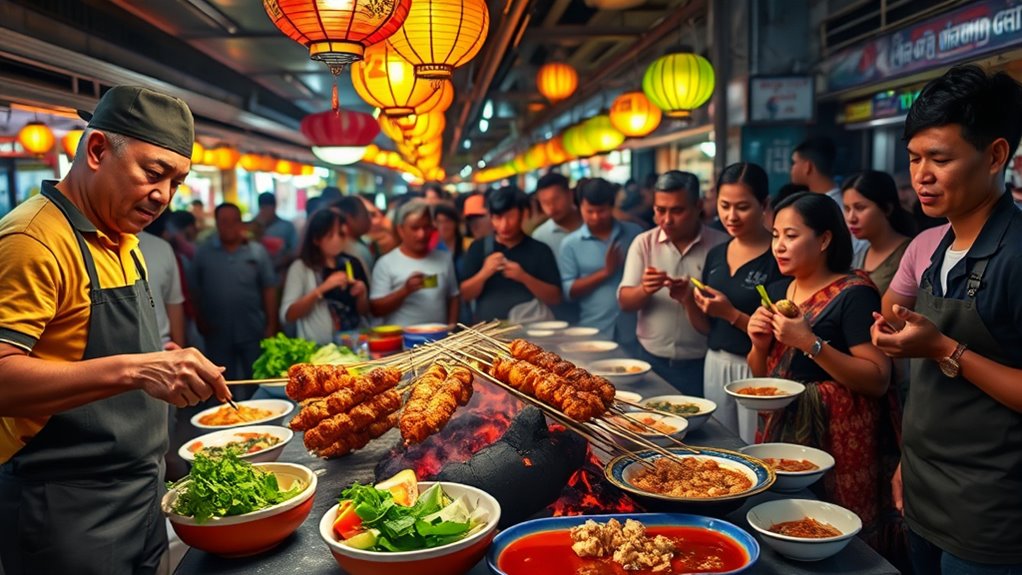To enjoy street food like a local without getting sick, focus on hygiene cues at stalls—look for clean utensils, covered ingredients, and vendors who wash their hands regularly. Choose vendors cooking fresh food in front of you and avoid anything that smells off or looks unappetizing. Trust your senses and observe cleanliness to spot red flags. Mastering these tips will help you savor safe, delicious street eats and stay healthy throughout your adventure.
Key Takeaways
- Choose stalls with clean, organized surfaces and vendors practicing regular hand hygiene.
- Opt for freshly cooked foods prepared in front of you rather than pre-cooked, sitting items.
- Check that ingredients are stored covered, off the ground, and free from flies or dust.
- Observe if vendors wear gloves or use tongs, indicating proper handling practices.
- Trust your senses—avoid food that smells or looks unappetizing or unclean.

Street food offers delicious and convenient options, but ensuring its safety is essential for enjoying it without health risks. When you’re exploring local markets or bustling street stalls, paying attention to how food is handled can make all the difference. Good food handling practices are the backbone of safe street food. Watch how the vendors prepare and serve their dishes—are they using clean utensils? Do they keep raw and cooked foods separate? If you see food exposed to dust or flies, it’s best to steer clear. Vendors who practice proper food handling often wear gloves or use tongs, minimizing direct contact with the food. Also, check if the food is kept at the right temperature—hot foods should stay hot, and cold items should remain chilled to prevent bacteria growth. If the vendor seems lax about these details, your best move is to find a stall that prioritizes hygiene.
Hygiene practices go hand in hand with food handling and are essential in avoiding foodborne illnesses. Look for stalls where the vendor’s hands and workspace appear clean. Are they washing their hands regularly or using hand sanitizer? Is the cooking area tidy and free of clutter? These signs indicate a focus on hygiene. Also, observe how ingredients are stored—fresh produce and meats should be covered or stored off the ground. If you notice raw ingredients lying out in the open or exposed to flies, it’s a red flag. When possible, choose vendors who have a visible cleaning routine and use sanitized tools. Freshly prepared food is often safer, so opt for stalls where food is cooked in front of you rather than pre-cooked items that have been sitting out. Additionally, understanding food safety standards can help you make better choices when selecting street vendors. Trust your senses—smell, sight, and even touch can tell you a lot about hygiene. If the food smells off or looks unappetizing, don’t risk it. Even if it smells fine, if the stall looks unclean or the vendor appears unhygienic, it’s better to find another spot. Paying attention to handling procedures and cleanliness cues can significantly reduce your chances of getting sick. Also, consider whether the vendor has proper hygiene practices in place, such as using disposable gloves or cleaning surfaces regularly. While street food is an exciting way to experience local culture, it’s essential to prioritize safety. By paying attention to food handling and hygiene practices, you can enjoy authentic flavors without compromising your health. Remember, a good street food vendor understands that cleanliness attracts more customers, so they’ll usually display good practices openly. Trust your instincts, stay alert to cleanliness cues, and you’ll be able to indulge in street food safely and confidently.
Frequently Asked Questions
How Can I Identify Clean Street-Food Vendors?
To identify clean street-food vendors, look for good vendor hygiene and fresh ingredients. Observe if the vendor’s hands are clean, if they use gloves or utensils, and if the stall is tidy. Check if the food looks freshly prepared and appealing. Avoid vendors with dirty setups, and trust your instincts. When you see consistent cleanliness and fresh food, you can confidently enjoy the local flavors without worry.
Are Street Foods Safe for Children and Pregnant Women?
You might think street foods are always safe, but health risks and nutritional concerns can affect children and pregnant women more. While some street foods are delicious, they may carry bacteria or contaminants that pose serious health risks. For vulnerable groups, it’s better to choose vendors with high hygiene standards and freshly cooked items. Always prioritize safe eating habits and consult health advice to protect your loved ones.
What Should I Do if I Get Food Poisoning?
If you get food poisoning, you should rest and stay hydrated with clear fluids. You can try home remedies like ginger tea or electrolyte solutions to ease symptoms. Monitor your condition—if you experience severe dehydration, high fever, blood in stool, or symptoms persist beyond a couple of days, it’s time to see a doctor. Prompt medical attention helps prevent complications and guarantees proper treatment.
How Long Can Street Food Be Left Unrefrigerated?
They say “a stitch in time saves nine,” and that’s true for food safety too. If street food isn’t refrigerated, you shouldn’t leave it out for more than two hours. Proper food storage is key to spoilage prevention. After that, bacteria can grow rapidly, making it unsafe to eat. Always keep perishable items chilled or consume them quickly to avoid foodborne illnesses.
Are There Specific Street Foods to Avoid in Certain Regions?
You should be cautious about regional food risks, as certain street foods may carry higher health concerns based on local practices and ingredients. Avoid dishes with raw or undercooked seafood, dairy, or meats in regions where hygiene standards are uncertain. Cultural food preferences influence what’s common, but staying alert helps you enjoy authentic experiences safely. Trust your senses, ask locals about safe options, and steer clear of foods that seem suspicious or poorly prepared.
Conclusion
By following these tips, you’ll navigate street food stalls like a seasoned traveler, turning every bite into a safe and flavorful adventure. Think of it as dancing through a busy market—your awareness keeps you in step, avoiding the pitfalls. With a little caution and smart choices, you’ll enjoy the vibrant tastes without turning your trip into a cautionary tale. Embrace the local flavors confidently, and let your taste buds explore safely, like a bird soaring through a lively marketplace.










